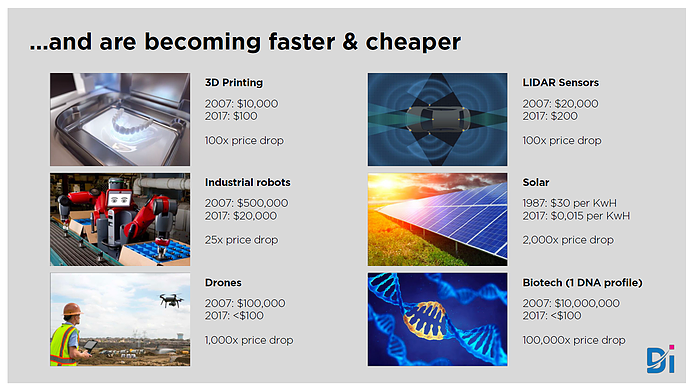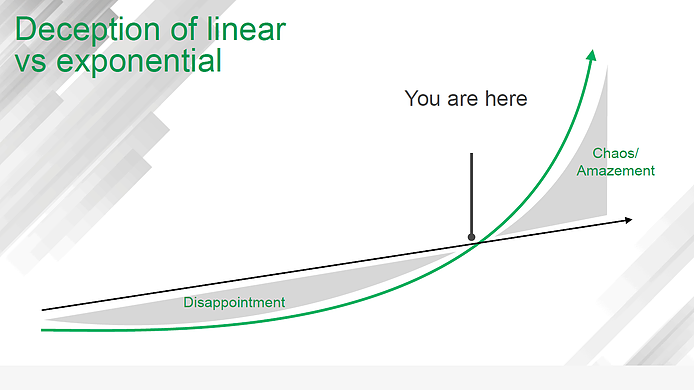I need to state upfront that the concept of the Exponential Organisation comes from a book by Salim Ismail fittingly called “Exponential Organizations” and this blog features work done by Peter Diamandis - co-founder of the Singularity University, Rob van Alphen – CEO of School of Disruption and Francisco Palao – CEO of OpenExO.
What is an exponential organization?
Essentially an exponential organization is a company that grows at an above-average rate – up to ten times faster than comparable companies in the industry – but can make do with considerably fewer resources thanks to new forms of organization and the use of new, especially digital, technologies.
Exponential Organisations are synonymous with digital transformation and the so-called Fourth Industrial Revolution.
Is this just a new management or consulting fad? Absolutely not! The leading companies today are growing exponentially. Examples of these companies are Amazon, Uber, Airbnb, Spotify and Netflix.
In the past, it was said that if a company isn’t innovating it will fall behind and run the risk of becoming irrelevant. The usual companies like Kodak and Nokia are mentioned here but we have companies in my country, South Africa, some of them who have been around for more than 100 years, that are rapidly moving towards extinction. I believe this extends even further today where it is becoming increasingly clear that if a company isn’t growing exponentially then it runs the risk of falling behind the competition with terminal consequences.
Exponential Organisations are directly linked to the exponential technology explosion that is taking place. This explosion relates to Moore’s law, the 6 Ds of technology disruption and convergence.
Don’t worry this blog won’t be an intellectual discussion. I personally have to dumb things down so that I understand them and so my hope is that it will make sense to you as well.
Moore’s law
To understand the concept of exponential technology we have to start with Moore’s law. When you look at Moore’s law you might think that it only applies to techies and people in white coats. Please stick with me because you will see how Moore’s law applies to technology advancement in general.
Here is Moore’s law:
“The number of transistors on a microchip doubles every two years, though the cost of the computers is halved”.
Incredibly this law is still true today. You can find the details on the dedicated Wikipedia page found here.
The thing is that our brains find it difficult to think in an exponential way. Let’s look at an example. Let’s pretend that my daughter Jessica came and asked me for 1c but requested that I continue to give her money but doubled every day. On the last day of a 31-day calendar month, I would need to give her $10,737,418.
Moore’s law was introduced in 1965 which was 54 years ago. Divide that in half means that the power of the microchip has doubled 27 times since the introduction of Moore’s law. This has resulted in the incredibly powerful computers, phones and technology we have today. Now I said that Moore’s law applies to more than just microchips. Here is a slide taken from a presentation by Rob van Alphen, CEO of School of Disruption, titled “Becoming an Exponential Organization”.

Isn’t that unbelievable!
We can see Moore’s law in everyday life. The cost of television sets for example that continuously gets better but are actually also getting cheaper.
The 6 Ds of technology disruption
Peter Diamandis, a co-founder of Singularity University, studied the exponential growth concept and saw that the growth cycle of technology took place in six key steps: digitization, deception, disruption, demonetization, dematerialization, and democratization.
Let’s look at each of the Ds above and use digital photography as an example.
Digitization: This applies to anything that becomes digitized. Kodak is an often-stated example with their mistake of not pursuing digital photography.
The key element of something being digital is that it becomes easy to access, share and distribute – like photos are today.
Deception: Because the doubling process in exponential growth takes place slowly at first the growth can initially be disappointing. The doubling is in fact taking place - just from a low base.
Here is a graph that shows this.
 Extracted from Salim Ismail’s presentation on Exponential Disruption
Extracted from Salim Ismail’s presentation on Exponential Disruption
Disruption: Here is where it gets interesting. At a breakthrough point, the new digital product exceeds the current product and service in both effectiveness and cost. That was the critical moment in the digital photography example.
Demonetized: As the exponential growth increases and the costs are reduced the technology becomes increasingly cheaper – often to the point where it becomes free. Think about how much it costs you to take a photograph of your children today.
Dematerialized: This just means that things become smaller and cheaper. The now common tool of the photographer is the mobile phone. This has shrunk from being the brick in 1973 to an extremely powerful tool that can fit into a person’s pocket.
Democratized: The last D is when the technology becomes commonplace. It has moved from being something that only the powerful and rich can afford to something that almost everyone can own and use.
This shows how the 6 D’s of disruption now makes products and services cheaper and easier to use. The new Exponential Organisations take advantage of this and use these digital technology advancements to offer products and services that are 10X more profitable and cost-effective than those of their competitors.
The convergence of exponential technologies
The last thing that will blow your mind is that technologies are not growing exponentially in isolation. There is something called the “Law of Accelerating Returns” or the “Law of Accelerating Convergence”.
Here is an extract from a Medium article titled “Progress is about the Convergence of Technologies”, produced by Singularity University:
“The strangest, most interesting and magical-seeming creations of the future will occur at the intersection of multiple exponential trend lines. …As technology continues to exponentially accelerate, the interactions between various subsets of exponential technology will create opportunities to slingshot past the already breakneck speed of accelerating change in ways that are even stranger and more difficult to predict than the path of any individual exponential technology.”
Here are some examples:
- Self-driving cars: Artificial intelligence, Internet of Things (IoT), big data and others.
- IBM Watson wins Jeopardy. This combined natural language processing, machine learning and big data.
- Siri/Google combining artificial intelligence with speech recognition and natural language interaction.
- Real-life stories consisting of virtual reality and artificial recognition.
- Optimal performance and productivity when you combine mobile and neuroscience.
Exponential Organisations are using, and creating, these converged exponential technologies to introduce products and services that again are better than the incumbent.
The rise of the Exponential Organisation
The continual exponential growth of technology, and the knowledge of how to use it, have given rise to the Exponential Organisations that are now the largest companies in the world. Start-ups, in particular, are using exponential growth.
I conclude this blog with this statement from Francisco Palao, CEO of OpenExO:
“Not long ago, it took 20 years to make a billion-dollar company. The new communication platform Slack did it in 8 months. Airbnb and Uber have reached 20 and 50 billion dollar valuations respectively in just 5 years putting the hospitality and transportation industry into panic mode.”
I hope you have enjoyed and found this blog valuable. If you are “Woken” up to the reality of the Exponential Organisation and would like to chat with me then please do. You can book me online using Calendly at https://calendly.com/ideastorm, contact me through my website at www.ideastorm.co.za or email me directly at lancepeppler@gmail.com.





Let Us Know What You Thought about this Post.
Put your Comment Below.